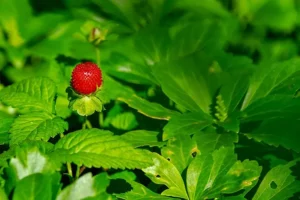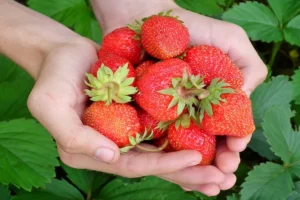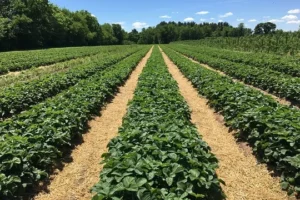What is Eating My Strawberry Leaves? If you’re a gardening enthusiast, the frustration of discovering your strawberry leaves being nibbled upon by unseen creatures can be quite disheartening. The health of your strawberry plants greatly depends on the condition of their leaves. In this post, we’ll describes into the common pests that may be devouring your strawberry leaves and provide effective strategies to identify, manage, and prevent these nuisances.
The Culprits: Who’s Behind the Munching?
Slugs and Snails
Slugs and snails are notorious for their nightly feasts on tender strawberry leaves. Their slimy trails and irregular holes on leaves are telltale signs of their presence.

Aphids
Aphids are tiny, sap-sucking insects that cluster on the undersides of leaves. They cause leaves to curl and become distorted, eventually weakening the plants.
Japanese Beetles
Metallic green Japanese beetles can cause significant damage by devouring both the leaves and flowers of strawberry plants.
Birds
Birds, including sparrows and robins, can peck at strawberry leaves and fruit. Their presence is often indicated by half-eaten or pecked-off leaves.
Identifying the Damage: How to Detect the Intruders?
Visual Inspection
Carefully examine your strawberry plants at different times of the day for any visible pests. Look for holes, discoloration, or curled leaves.
Night Patrol
For slugs and snails, conduct a nighttime inspection with a flashlight. They are most active during damp and dark conditions.
Use of Traps
Set up traps, such as shallow dishes filled with beer, to attract and drown slugs and snails. Sticky traps can be effective against flying pests like aphids.
Taking Action: Managing the Pests
Natural Predators
Encourage natural predators like ladybugs and birds that feed on insect. Consider setting up bird feeders near your strawberry patch.
Neem Oil Spray
A neem oil spray can deter a variety of pests, including aphids and beetles. It disrupts their life cycles and reduces their feeding.

Physical Barriers
Protect your plants with physical barriers such as row covers to prevent birds and other creatures from accessing your strawberry patch.
Prevention Is Key: Keeping the Pests at Bay
Regular Pruning
Trim damaged leaves and remove any dead or decaying plant matter to eliminate hiding spots for pests.
Proper Spacing
Plant your strawberry plants with enough spacing to reduce overcrowding, which can attract pests and promote disease.
Clean Surroundings
Keep the area around your strawberry plants clean and free of debris, as pests often hide in debris and weeds.
How do you treat strawberry leaf disease?
Strawberry plants can be susceptible to various diseases, including leaf diseases. One common leaf disease is “Leaf Spot” or “Leaf Blight,” caused by different fungal pathogens such as Diplocarpon earlianum and Mycosphaerella fragariae. To treat strawberry leaf disease, you can follow these steps:
Prune and Remove Infected Leaves
Start by inspecting your strawberry plants regularly. If you notice any leaves with spots, discoloration, or lesions, carefully remove and dispose of them. By doing this, the disease will be stopped from spreading to healthy areas of the plant.
Improve Air Circulation
Proper air circulation is crucial for preventing the development and spread of fungal diseases. Make sure your strawberry plants are not overcrowded and have enough space between them for air to flow freely.
Water Management
Avoid overhead watering, as wet foliage can encourage the growth of fungal pathogens. Instead, water the soil around the plants, preferably in the morning, so the leaves have a chance to dry during the day.
Mulching
Place a coating of natural mulch, like straw or wood chips, in a circle surrounding the plants.
Fungicide Treatment
If the disease is severe or recurring, you might consider using fungicides labeled for use on strawberries. Consult your local garden center or agricultural extension service for recommendations on suitable fungicides and application instructions.
Rotate Crops
If you’re growing strawberries in a garden bed, practice crop rotation. Avoid planting strawberries in the same area where they were planted the previous year. This helps break the disease cycle and reduces the risk of reinfection.
Sanitation
Keep your garden area clean by removing debris, fallen leaves, and other plant material that could harbor disease-causing pathogens.
Resistant Varieties
When selecting strawberry varieties, consider choosing those that are known to be resistant to leaf diseases. Resistant varieties can be less susceptible to infections.
Early Detection
Check your plants frequently for any indications of illness. Catching infections early can make treatment more effective and prevent the disease from spreading further.
Consult Experts
If you’re unsure about the specific disease affecting your strawberry plants or the best course of action, consider reaching out to your local agricultural extension service or a professional horticulturist for guidance tailored to your region.
Prevention is often the most effective strategy. Maintaining good garden hygiene, proper spacing, and providing optimal growing conditions can go a long way in preventing and managing strawberry leaf diseases.
What type of fungicide is applied to treat leaf spot on strawberries?
One commonly used fungicide for controlling leaf spot on strawberries is captan. Captan is a broad-spectrum fungicide that is effective against various fungal diseases, including leaf spot. The mechanism of action involves the suppression of fungal growth and the containment of disease progression.

However, it’s important to note that the availability and recommendations for specific fungicides can vary depending on your location and local regulations. Before using any fungicide, it’s recommended to consult with local agricultural extension services or experts to ensure that you are using the appropriate product and following proper application guidelines.
FAQs
Can I use chemical pesticides to control these pests?
While chemical pesticides are an option, they can also harm beneficial insects and impact the environment. It’s recommended to explore natural alternatives first.
What is the recommended frequency for checking my plants for pests?
Regularly inspect your plants at least once a week, but increase the frequency during the growing season to catch any issues early.
Will companion planting help deter pests?
Yes, certain plants like marigolds and garlic can act as natural repellents. Research companion planting strategies for strawberries.
Are there any organic fertilizers that can improve plant resistance?
Yes, organic fertilizers rich in nutrients can enhance the overall health and resistance of strawberry plants to pest attacks.
Can I move potted strawberries indoors to avoid pests?
Yes, moving potted plants indoors during the night can help protect them from pests like slugs and snails.
Final Thoughts
It is common question that, What is Eating My Strawberry Leaves? Maintaining the health and vitality of your strawberry plants is essential for a bountiful harvest. By identifying and managing the pests that munch on your strawberry leaves, you can protect your plants and enjoy delicious strawberries for years to come.